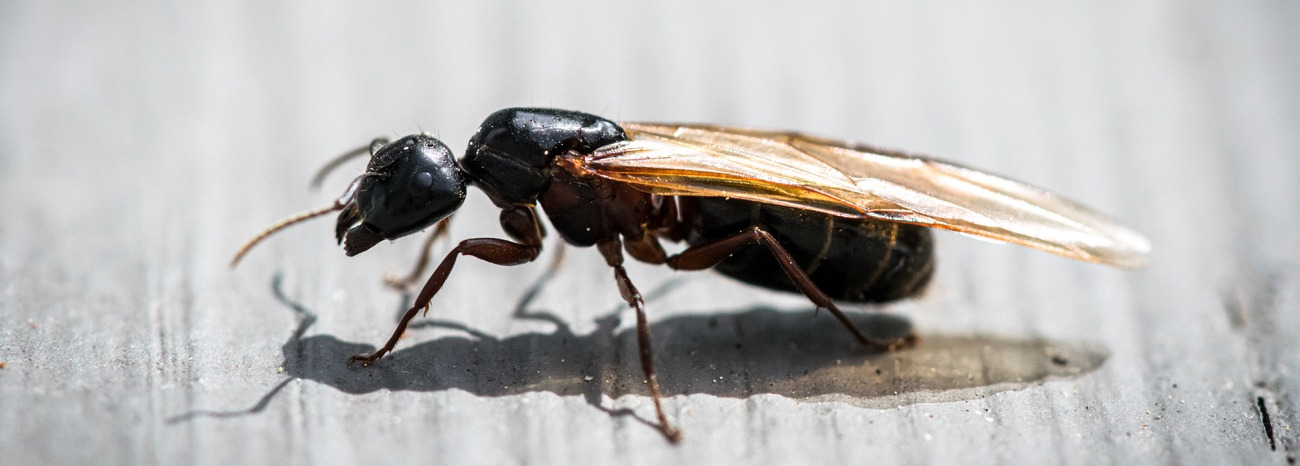Flying ants and winged termites are two insects that are often confused with each other. Knowing how to identify them can mean the difference between dealing with the minor nuisance of flying ants or suffering the cost and aggravation of significant structural damage to our home due to a termite infestation. If you’re noticing an unfamiliar type of flying insect around your property or in your home, it’s important to find out exactly what it is.
Why Do Termites and Ants Fly?
When termite and ant colonies are ready to expand, the members of the colonies with reproductive roles will emerge and “swarm,” flying in large groups in what is called a nuptial flight. They do this in search of mates so they can establish new colonies.
The worker ants and worker termites are the sterile members of their colonies. They do not have wings.
Flying ants (also known as carpenter ants) will swarm in the late spring and early summer, ideally after several days of rain. Termite swarms usually happen in the spring, also after rainfall.
How to Tell the Difference Between Termites and Flying Ants
Appearance
You can tell the difference between flying ants and termites by these physical characteristics:
Wings
- Termite wings are equal in length and usually twice as long as their bodies.
- Flying ants’ wings are unequal in length. Their front wings are larger than their hind wings.
Antennae
- Termites have straight antennae
- Flying ants have bent, or “elbowed” antennae
Abdomen
- Termites have wide bodies with no discernable waist.
- Flying ants have bodies that are segmented, with pinched waists.
Coloring
- Termites are black or dark brown with clear wings.
- Flying ants are black, brown or reddish in color with brown-tinted wings.
Habitat
- Flying ants prefer to set up their colonies outside. They thrive in a warm climate with sources of moisture. They will only enter your home in search of food or water.
- Termites, on the other hand, establish their colonies indoors. They do this for the safety and the food sources an indoor space provides. Prime spots are anywhere there is rotted wood and decay, like basements, underneath siding or along rooflines.
Diet
- Ants are omnivores whose main sources of food include nectar, seeds, other insects and food debris found in and around your home.
- Termites eat anything with a cellulose base: wood, paper – including sheetrock paper and cardboard, carpet, insulation and plants.
Lifecycle
- Both ants and termites go through metamorphosis.
- The queens of termite and ant colonies can live for years, even decades.
- Worker ants live only for a few months.
- The termite lifespan is several years. Males and females will live after mating, continuing to create new colonies.
- Both flying ants and termites lose their wings after mating. Male partners will die after mating with the female ants.
Termites vs Flying Ants: Telltale Signs
Now that you know how to identify flying ants and termites, what are some other signs you can look for to know which kind of insect you’re dealing with?
Discarded Wings
If you’re seeing a significant number of discarded wings in your window sills or other places around your home, you are probably dealing with a termite infestation. This is because even though both flying ants and termites lose their wings after mating, termites will do so at a higher rate.
Dead Ants
Because male flying ants die after mating, you might find them lying in or around your home.
Structural Damage
Ants might choose to live inside the wooden areas of your home. However, since they don’t eat wood, their stay won’t result in the same structural damage as termites.
Signs of a termite infestation include:
- Small piles of sawdust or other visible wood damage
- Hollow-sounding wood
- Extremely squeaky floorboards
- Rotting wood
- Peeling paint
Now That You Know the Difference Between Flying Ants and Termines – Here’s What To Do
Now that you know what you’re dealing with you can take action.
You might have some success getting rid of flying ants with DIY methods but if you don’t remove the colony (or colonies) they will keep coming back. It’s best to bring in professional pest control experts.
Termites are next level. You do not want to delay getting professional termite control. You need to find out how much damage they might have already done and remove them from your property. Start by contacting us to schedule a termite inspection.
Call 215.799.2010 or use the form below to contact us.

